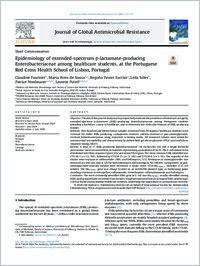Epidemiology of extended-spectrum β-lactamase-producing Enterobacteriaceae among healthcare students, at the Portuguese Red Cross Health School of Lisbon, Portugal
- Fournier, Claudine Medical and Molecular Microbiology Unit, Faculty of Science and Medicine, University of Fribourg, Fribourg, Switzerland
- Aires de Sousa, Marta Escola Superior de Saúde da Cruz Vermelha Portuguesa (ESSCVP), Lisbon, Portugal - Laboratory of Molecular Genetics, Instituto de Tecnologia Quimica e Biológica (ITQB) António Xavier, Universidade Nova de Lisboa (UNL), Oeiras, Portugal
- Fuster Escriva, Begoña Medical and Molecular Microbiology Unit, Faculty of Science and Medicine, University of Fribourg, Fribourg, Switzerland
- Sales, Leila Escola Superior de Saúde da Cruz Vermelha Portuguesa (ESSCVP), Lisbon, Portugal
- Nordmanna, Patrice INSERM European Unit (IAME, France), University of Fribourg, Fribourg, Switzerland - Swiss National Reference Center for Emerging Antibiotic Resistance (NARA), University of Fribourg, Fribourg, Switzerland - Institute for Microbiology, University of Lausanne and University Hospital Centre, Lausanne, Switzerland
- Poirel, Laurent Medical and Molecular Microbiology Unit, Faculty of Science and Medicine, University of Fribourg, Fribourg, Switzerland
-
01.09.2020
Published in:
- Journal of Global Antimicrobial Resistance. - 2020, vol. 22, p. 733–737
English
Objective: The aim of the present study was to prospectively evaluate the prevalence of intestinal carriage by extended-spectrum β-lactamase (ESBL)-producing Enterobacteriaceae among Portuguese students attending a Bachelors’ course in healthcare, and to determine the molecular features of ESBL-producing isolates.Methods: One-hundred and eleven faecal samples recovered from Portuguese healthcare students were screened for either ESBL-producing, carbapenem-resistant, colistin-resistant or pan-aminoglycoside-resistant Enterobacteriaceae, using respective screening media. All recovered isolates were tested for antimicrobial susceptibility and characterised by pulsed-field gel electrophoresis (PFGE) and multilocus sequence typing (MLST).Results: A total of 17 ESBL-producing Enterobacteriaceae (16 Escherichia coli and a single Klebsiella pneumoniae) were recovered from 16 students, representing a prevalence of 14.5%. The E. coli isolates were distributed into three sequence types (STs) and seven PFGE types. The most common ESBL identified was CTX-M-1 (n = 13; 76%), followed by CTX-M-15 (n = 3; 18%) and CTX-M-8 (n = 1; 6%). The majority of the strains were resistant to sulfonamides (88%) and fosfomycin (71%). Resistance to aminoglycosides was observed at a low rate, that is 12% for both tobramycin and kanamycin. No colistin-, carbapenem- or pan-aminoglycoside-resistant isolates were recovered. A major clone, ST10-blaCTX-M-1, included 12 E. coli isolates. The blaCTX-M-1 gene was always located on an IncFIA/FIB plasmid type, co-harbouring genes encoding resistance to tetracycline, sulfonamides, trimethoprim– sulfamethoxazole and fosfomycin.Conclusion: The most commonly identified ESBL gene in E. coli was blaCTX-M-1, usually identified among ESBL-producing isolates recovered from animals. A high prevalence of faecal carriage of ESBL-producing E. coli was found among healthy healthcare students, underlying this population as an important reservoir.
- Faculty
- Faculté des sciences et de médecine
- Department
- Médecine 3ème année
- Language
-
- English
- Classification
- Biological sciences
- License
-
License undefined
- Identifiers
-
- RERO DOC 329639
- DOI 10.1016/j.jgar.2020.07.004
- Persistent URL
- https://folia.unifr.ch/unifr/documents/309061
Statistics
Document views: 109
File downloads:
- pdf: 238
